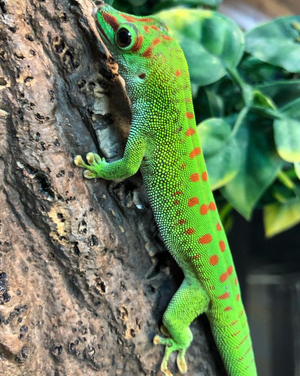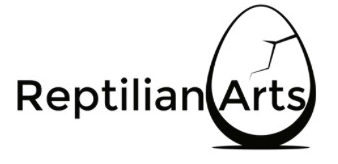Giant Day Gecko Care

Giant Day Gecko Care Guide
Basic Information
Giant day geckos, originally from the subtropical regions of Madagascar, are a colorful, larger arboreal gecko species that is very active and comes in various colors. Male giant day geckos can grow almost a foot long, while females are generally smaller. Due to their size and vibrant color, giant day geckos are popular as beginner reptiles. Giant day geckos can live up to 15-20 years with proper care.
Health
A common issue that giant day gecko owners may face is a stuck shed. A stuck shed occurs when humidity levels drop too low, preventing the gecko from naturally shedding. A simple remedy is to mist the enclosure to create a more humid environment that encourages the gecko to shed. If the stuck shed persists, soaking the gecko in a shallow bin of warm water for 15-30 minutes is recommended. **Be very careful, as stuck sheds and eye caps are a significant possibility for geckos. This can result in losing limbs and eyes, so monitor every shed cycle to ensure no difficulties arise.
Geckos need a supplement of calcium and D3 in their diet every so often, which can be done by dusting their regularly consumed insects or food. Otherwise, they can develop metabolic bone disease or MBD. This can look like deformed or weakened limbs and a weaker jaw, which can prevent the gecko from being able to eat correctly. Increase calcium and D3 intake as needed. **It is recommended that their food be dusted weekly with calcium/D3 supplement.
Do not ever handle a gecko by its tail. They will drop their tails if stressed or handled roughly. Giant day geckos will grow their tail back, but it will not be the same as the original. **Giant Day geckos have much more delicate skin than other gecko species, so only handle them if necessary.
Enclosures
These geckos need large, taller terrariums to accommodate their arboreal nature. A 60- 75-gallon enclosure is recommended for one gecko. If you want to house more, move up to a bigger size. Baby giant day geckos can be housed in a 20-gallon enclosure before moving up. Front-opening enclosures are better for feeding and changing whatever needs to be changed. The enclosure should have plenty of climbing objects, which include branches, vines, and foliage. Some of these climbing objects should be close to the basking spot, but not too close to prevent overexposure to UVB or potential burns. The foliage in the terrarium should be placed around all sides to catch the water from misting, providing multiple drinking spots. Include magnetic or suction cup ledges to hold their food in the terrarium and for additional spots for perching or climbing.
Heating/Lighting
It’s recommended that the warm end be towards the top of the enclosure, as these geckos will spend time higher up, and the cold end be towards the bottom. The basking area should have a relatively higher temperature, reaching about 85-90 degrees Fahrenheit, while the colder end should only get around 72-80 degrees Fahrenheit. Since they are from a tropical climate, they need higher temperatures and humidity levels, so be sure to have the enclosure in an area that doesn't get too cold. Basking bulbs should be used at the top of the enclosure during the day. At night, a heat mat can be used instead to ensure the temperature in the enclosure doesn’t drop too low. Use a thermometer with probes to monitor the temperature at each end.
A UVB bulb is also recommended, alongside the listed daylight basking bulb. This can be turned on alongside the day bulb and turned off at night. When considering the bulb choice, you must consider the distance between the lamp and the geckos.
Substrate
Giant Day Geckos will spend most of their time climbing or high up. However, substrate is still recommended for aiding humidity and being a cushion in case they fall. Substrates like coconut husk, jungle mix, and tropical blend are good day gecko options. Not a lot is needed; a 2-inch layer will suffice. Spot clean as needed and replace every few months.
Humidity
A moderate humidity of 50-65% is recommended for giant day geckos. The best way to maintain moisture for these arboreal geckos is to mist the enclosure daily with a spray bottle. You want to gently mist the enclosure enough for running water, as giant day geckos prefer running water to standing water. The misting should be sufficient for the day. Use a hygrometer to monitor humidity.
Water
Although they might not drink from it often, a small water bowl should be placed inside the enclosure. If you can, put it near or with their feeding ledge.
Food
Giant day geckos eat a variety of animal-based foods and plant-based foods. Animal-based foods include various insects: crickets, dubia roaches, grasshoppers, and locusts. Mealworms, waxworms, and silkworms can be fed as an occasional treat. For the plant option, we recommend using crested gecko pangea diet powders as they meet all the nutritional requirements of day geckos. For younger day geckos, feed insects daily and the crested gecko food every 2-3 days. For adults, feed insects every 2-3 days and crested gecko food once a week. Their crested gecko food should be on a ledge in the terrarium rather than on the bottom of the enclosure. Be sure to dust insects with supplement powder every so often.
